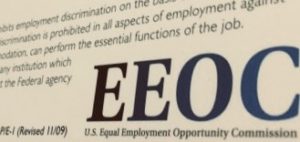LATEST UPDATE ON EEO-1 COMPENSATION DATA REPORTING REQUIREMENT
On April 3, 2019, the Equal Employment Opportunity Commission (EEOC) informed a U.S. District Court that it will need to extend the employee compensation data reporting on the EEO-1 from May 31, 2019 to September 30, 2019.
The EEOC requires employers with more than 100 employees to report the number of employees based on race, gender, ethnicity and job category on an annual report known as the EEO-1. Last month, the U.S. District Court reinstated the compensation data requirement on the EEO-1.
Until recently, employers were not required to report employee compensation on the EEO-1. In 2016, during the Obama administration, the EEOC announced its intention to begin collecting employee compensation data on the EEO-1. Shortly before the election of 2016, the Office of Management and Budget (OMB) approved the revision to the EEO-1 with the 2017 data that was to be reported by employers in March of 2018. Prior to the implementation of the newly revamped EEO-1, the Obama administration ended and the Trump administration began, and in August of 2017 the OMB announced a stay of the compensation data requirement while it reviewed whether the practical utility of the revised collection of information was unnecessarily burdensome on employers and whether it adequately addressed privacy and confidentiality issues.
In November of 2017, the National Women’s Law Center (NWLC) filed suit with the U.S. District Court in Washington, D.C. to vacate the stay issued by the OMB and reinstate the reporting requirement of compensation data on the EEO-1. Last month Judge Tanya Chutkan agreed with the NWLC. Thus, employer reporting of their employee compensation is now required on the EEO-1 again.
On March 18, the EEOC released the EEO-1 form and announced (because of the government shutdown) an extension of the deadline for employers to file the EEO-1 until May 31, 2019. Following the court’s ruling, the Trump administration, the OMB and the EEOC have been unusually quiet on providing guidance to employers or insight into their next move, particularly since the window to file the EEO-1 is now open. With regard to the compensation data requirement and the U.S. District Court’s order, the EEOC merely announced that it “is working diligently on next steps in the wake of the court’s order”, and “the EEOC will provide further information as soon as possible”.
Judge Chutkan gave the EEOC until April 3, 2019 to respond with a plan as to how the compensation data would be collected and by what deadline. On April 3, the EEOC reported to the court that it will need to extend the deadline to collect employee compensation data until September 30, 2019. The EEOC noted that the extension was necessary in order to accommodate the “significant practical challenges” and that modifying its current processes in collecting data would take nine months.
The U.S. District court is likely to approve the extension (or some form of extension) but has not done so yet. Meanwhile, employers should NOT assume the deadline has been extended beyond May 31 until or unless the court issues an order stating such. Until then, employers should continue to assume that the reporting of employee compensation data on the EEO-1 remains due on May 31, 2019.
It is assumed that the U.S. Department of Justice will appeal the District Court’s order and seek a stay pending appellate review. Again, however, until a court issues a stay, the current order from the court still stand and employers should proceed on the basis of a May 31, 2019 deadline.
Employers should be mindful that equal compensation will continue to be an issue in the landscape of employment law. The U.S. House of Representatives recently passed the Paycheck Fairness Act (which is not likely to gain approval by the Senate in its current form or the Executive Branch), and several states have enacted gender equality or similar compensation laws. Additionally, there remain various federal laws and regulations on the books designed to propel employers toward compensation equality. As the NWLC challenge in court shows, there is growing awareness of gaps in wages and compensation. Advocates like the NWLC hope that by forcing employers to report (and thus reveal) gaps in employee compensation through the EEO-1 that employers will be pressured to address variances in compensation.
Employers should monitor their employee compensation to ensure equity and consider an employee compensation analysis under the protections of attorney-client privilege to identify variances, factors that explain differences in compensation, and make any appropriate adjustments.
If you have questions as to how to collect compensation data or ensure compliance with EEO-1 reporting, please contact Curt Mistele.

